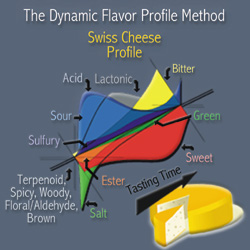
Flavor Dynamics Inc., South Plainfield, N.J., has developed the Dynamic Flavor Profile Method, which enables food technologists to follow changes in flavor attributes over time.
Traditional methods of sensory analysis identify flavor attributes and then measure their intensity. These are often mapped out on a spider web-like grid where the points on the web represent flavor attributes and the length of each attribute line from the center point represents intensity.
"We show the time intensity of a flavor within a three-dimensional model," says Dolf DeRovira, president, Flavor Dynamics. "The changes of intensity become a curve." The various curves representing each taste attribute in a different color combine into one three-dimensional tube-shaped model.
The traditional spider web graph does not account for the variations in the actual taste experience. "Light compounds come first, and heavier volatiles next," explains DeRovira. "Of the non-volatiles, salt comes first, sweet in the middle and bitter in the back. Acids, which are also non-volatiles, come up front. Tasting a product takes from less than three seconds to up to 15 seconds for something like chewing gum. Perception of a flavor or nuance changes within the brief tasting experience."
The new method starts with a trained taste panel. Tasters are trained in 16 flavor attributes--aromas, non-volatiles and others. Aromas or volatiles are acids, esters, green, terpenoid, floral/aldehyde, spicy, brown, woody, lactonic and sulfury. The four non-volatile or main tastes are salt, sweet, bitter and sour. Panelists also detect umami taste and trigeminal tastes such as capsicum heat and tannin astringency.
Tasters enter their data into the computer as they taste. For each taste attribute, they use the mouse to indicate variations in its intensity as it occurs. The computer program averages the responses of the taste panel, and shows the result as the area under a curve. Each curve is a different color. The program combines the various curves for the attributes of a taste experience into a multicolored undulating cylinder on the screen.
The system has many applications for food technologists. Developing a new taste concept or matching a target product is only the beginning. Product improvement is a big area. Suppose a desired attribute disappears and then returns. Selecting an ingredient that profiles predominantly in the right time zone can round out the flavor profile.
When a product is modified to reduce fat content, a change may be observed in the topnote and loss of creaminess may be detected in the middle. The system can analyze the effect of different types of vegetable oils or fat replacers in the product, and indicate which formulation has the profile closest to the original. If an off-flavor develops during processing, the system can identify when the off-note appears. Formulators can add another ingredient that hits the palate at that point to mask the off-note. Food scientists can also use the system for developing quality standards and for storage stability testing.
Flavor Dynamics offers free one-day courses to help food product developers learn to use the system and experience the way it works with various food products.